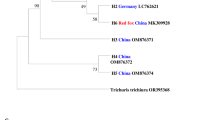Abstract
Two out of five members of one household presented with clinical signs of trichinellosis after their return to the Netherlands. The family had consumed Trichinella-infected pork in Montenegro, formerly Yugoslavia. Serological tests were performed at 1, 2, 6, and 18 months after ingestion of the infected meat. Trichinella-specific IgM, IgG, and IgA antibodies measured in sera from symptomatic and asymptomatic patients remained positive up to 18 months after ingestion. The measured IgG4 antibody response directed to a 45 kDa Trichinella spiralis antigen also persisted 18 months after ingestion for three of the family members.


Similar content being viewed by others
References
Touratier L (2001) A challenge of veterinary public health in the European Union: human trichinellosis due to horse meat consumption. Parasite 8:S252–S256
Gamble HR (1985) Trichinella spiralis: immunization of mice using monoclonal antibody affinity-isolated antigens. Exp Parasitol 59:398–404
Homan WL, Derksen AC, van Knapen F (1992) Identification of diagnostic antigens from Trichinella spiralis. Parasitol Res 78:112–119
Pinelli E, Lugt G van der, Homan W, Giessen JW van der, Kortbeek LM (2001) Antigen recognition by IgG4 antibodies in human trichinellosis. Parasite 8:S168–S171
Morakote N, Sukhavat K, Khamboonruang C, Siriprasert V, Suphawitayanukul S, Thamasonthi W (1992) Persistence of IgG, IgM, and IgE antibodies in human trichinosis. Trop Med Parasitol 43:167–169
Kociecka W (2000) Trichinellosis: human disease, diagnosis and treatment. Vet Parasitol 93:365–383
Djordjevic M, Bacic M, Petricevic M, Cuperlovic K, Malakauskas A, Kapel CM, Murrell KD (2003) Social, political, and economic factors responsible for the reemergence of trichinellosis in Serbia: a case study. J Parasitol 89:226–231
Ljungstrom I, Hammarstrom L, Kociecka W, Smith CI (1988) The sequential appearance of IgG subclasses and IgE during the course of Trichinella spiralis infection. Clin Exp Immunol 74:230–235
Aalberse RC, Gaag R van der, Leeuwen J van (1983) Serologic aspects of IgG4 antibodies. I. Prolonged immunization results in an IgG4-restricted response. J Immunol 130:722–726
Berends BR, Smeets JF, Harbers AH, Knapen F van, Snijders JM (1991) Investigations with enzyme-linked immunosorbent assays for Trichinella spiralis and Toxoplasma gondii in the Dutch ‘Integrated Quality Control for finishing pigs’ research project. Vet Q 13:190–198
Elbers AR, Dekkers LJ, Giessen JW van der (2000) Sero-surveillance of wild boar in The Netherlands, 1996–1999. Rev Sci Tech 19:848–854
Milne LM, Bhagani S, Bannister BA, Laitner SM, Moore P, Eza D, Chiodini PL (2001) Trichinellosis acquired in the United Kingdom. Epidemiol Infect 127:359–363
Author information
Authors and Affiliations
Corresponding author
Rights and permissions
About this article
Cite this article
Pinelli, E., Mommers, M., Homan, W. et al. Imported Human Trichinellosis: Sequential IgG4 Antibody Response to Trichinella spiralis . Eur J Clin Microbiol Infect Dis 23, 57–60 (2004). https://doi.org/10.1007/s10096-003-1039-7
Published:
Issue Date:
DOI: https://doi.org/10.1007/s10096-003-1039-7




